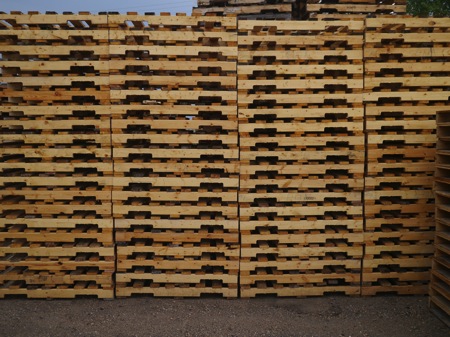Ok. I admit that it wasn’t exactly a pallet plant since the company no longer manufactures pallets there, but pallet plant is alliterative (in the most crass way) so more suitable than “a visit to a pallet redistribution facility.”

Anyway.
The guys at API Pallets here in Grand Forks were very generous with their time when even through Bret Weber and I encroached on their lunch break on a rainy Friday afternoon. They showed us around their facility and explained that pallets come in on trucks from “Canada” and are rated and then shipped out to clients throughout the region. They get a small quantity of pallets from local merchants, like the local pasta plant, but most of their inventory comes from other distribution centers. Their biggest client is a logistics firm in Casselton, ND situated on an important transportation corridor for rail and truck traffic through the northern plains.

As for the pallets themselves, we learned that API rates pallets with three grades. A1 pallets are clean, have no splinting or splitting, and have evenly spaced deck boards. One of the most interesting moments involved the guy using his fist to demonstrate the ideal width between deck boards. I’ll return to this. B1 and B2 pallets have light damage or have repairs. Irregularly spaced deck boards, the insertion of blocks to support broken stringers, or obvious splitting and splintering throughout leads to lower ratings. The difference in price between an A1 and B1/2 pallet is about $3. They do repair pallets to raise them to either A1 grade or B1/2 grade on site.

One thing Bret and I began to think about it the way in which the size of a pallet (48 x 40 inches) has impacted life in the Bakken (and elsewhere). For example, modular housing units like the most common in the Bakken are designed to move by rail or truck. Pallets, of course, are designed to fit inside containers, semi trailers, and rail cars and move about the country carrying standardized loads. The existence of this regular unit of measure and the tendency in the Bakken to use this scale to organize human activities, whether it is life or work, provides a highly visible means of standardizing the space of human activities.
It was heartening, then, to see the guy at the pallet plant use his fist to measure the distance between the deck boards. This gesture returned the pallet to the human scale.

The guys there also commented on the various stamps added to pallets to mark them as being used at a particular farm or factory. Since the pallet pool is an open pool, meaning that whoever possessed the pallets had the right to resell them, these stamps were meant to mark out simply one stage in the pallet’s life and to manipulate the standardized form of the object without compromising its functionality.
Finally, our reuse of pallets is important because it defies the functional expectations of these objects and reshapes them to our human existence rather than the opposite.

